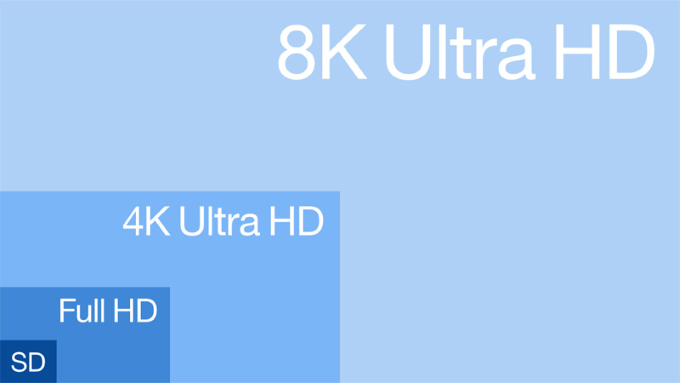When it comes to buying a new television or monitor as an inexperienced consumer, there are enough terms and acronyms to make you dizzy. There’s 720p, HD, 1080p, FHD, 2160p, UHD, 4K, and more – it can get overwhelming.

Without fully understanding the specifications of the display you’re considering, you’re opening yourself up to the opportunity of overpaying for something that underperforms. By today’s standards, using a 32-inch 720p TV as a computer monitor is borderline masochistic.
For those of you who aren’t satisfied with needing to sit a full 10 feet away from your TV for text to appear crisp, you’ve probably heard about 4K. Today, 4K display resolutions are considered the standard when it comes to high-quality streaming and gaming. The thing is, there are many people out there who aren’t exactly sure what 4K means or how it differs from terms such as UHD and 2160p.
In this article, let’s talk about the differences between 4K, UHD, and 2160p.
What Is 4K?
An easy way to remember the specifications of a true 4K display is by drawing comparisons based on the number (4,000) in this term. By definition, 4K displays have at least 4,000 pixels of horizontal display resolution. This commonly refers to the 4096 × 2160 display resolution, which totals 8 million active pixels. This resolution has four times the number of total pixels as a 1080p display.
However, the most commercialized 4K display resolution is 3840 × 2160. The first number, 3,840, is the display’s horizontal resolution, in pixels, and the second number, 2,160 is its vertical resolution. This seems to break the one and only rule of being 4K, yet it’s how the term has been adapted.

The term “4K” originally comes from a digital cinema resolution, now referred to as DCI 4K. The 3840 × 2160 display resolution is now the 4K standard due to how common it is among TVs and monitors. In the majority of cases, a 4096 × 2160 display resolution will either stretch and distort the picture or require black boxes across the top and bottom – neither of which consumers are happy to see.
So, to appease home consumers, 4K almost always refers to the 3840 × 2160 display resolution.
What Is UHD?
UHD stands for “ultra high definition”. Unlike 4K, where 4096 × 2160 is the true-to-definition resolution, a UHD display is definitely 3840 × 2160.
However, with how uncommon true 4K is, UHD and 4K are used in an interchangeable way. Speaking technically, though, a 3840 × 2160 display is only UHD.

Some retailers, rather than just using the two terms interchangeably, refer to 3840 × 2160 as 4K UHD, which is UHDTV1. 8K UHD is 7680 × 4320, referred to as UHDTV2.
Going back to what we originally said about the consumer-friendly definition of 4K, UHDTV1 (presently referred to as just UHD) and 4K are the same.
What Is 2160p?
The term “2160p” is used to describe display resolutions where the vertical resolution is 2,160 pixels. The “p” stands for “progressive scan,” sometimes referred to as “non-interlaced.”
Progressive scanning is a format in which the lines of each frame of a moving image are drawn in sequence. This comes in contrast to interlaced video, where the odd and even lines of each frame are drawn in an alternating fashion.
To put it simply, 2160p is to vertical resolution what 4K is to horizontal resolution. That being said, practically all 2160p display resolutions are also 4K (by its loose definition).
Wait, They’re All the Same?
To summarize and compare, a display can be both true 4K and 2160p (4096 × 2160). However, a UHDTV1 (presently referred to as just UHD) display is always 2160p, because it refers to a display resolution of 3840 × 2160.
When UHDTV2 (or consumer-friendly 8K) gains popularity, UHD will no longer be synonymous with 2160p because UHD is set to describe both 4K and 8K display resolutions. This is when the distinction of 4K UHD or 8K UHD will be more important to make.
Finally, due to the adapted definition of 4K, a 3840 × 2160 resolution can currently be referred to as all of 4K, UHD, and 2160p. So, in conventional cases and going by the loosened definition of 4K, they’re all the same.

When the term “4K” was coined, it brought much confusion to the display market. Consumers were familiar with 720p being referred to as HD (high definition) and 1080p being referred to as FHD (full high definition). When referring to 4K instead as being 2160p and UHD, it becomes uniform and simpler to digest.
However, retailers began shorthanding this display resolution as 4K. This may be because “2160p” just doesn’t roll off the tongue very well, but it broke a format that many consumers were getting used to. Even worse, “4K” is not technically accurate when referring to a resolution of 3840 × 2160 – an honest argument against the popularity of this term.
Another reason retailers may be eager to label everything as 4K is because lumping all of these confusing titles together makes the product sound more featureful. A 4K UHD 2160p TV sounds like such a bigger deal than a 2160p TV, right? Well, it’s rather redundant.
When you’re shopping for a new display at the latest standard of high definition, just know that a resolution of 3840 × 2160 is what you’re looking for. There are other acronyms and specifications that aren’t just fluff, though – for example, check out Online Tech Tips’ article on 4K vs. HDR and Dolby Vision.